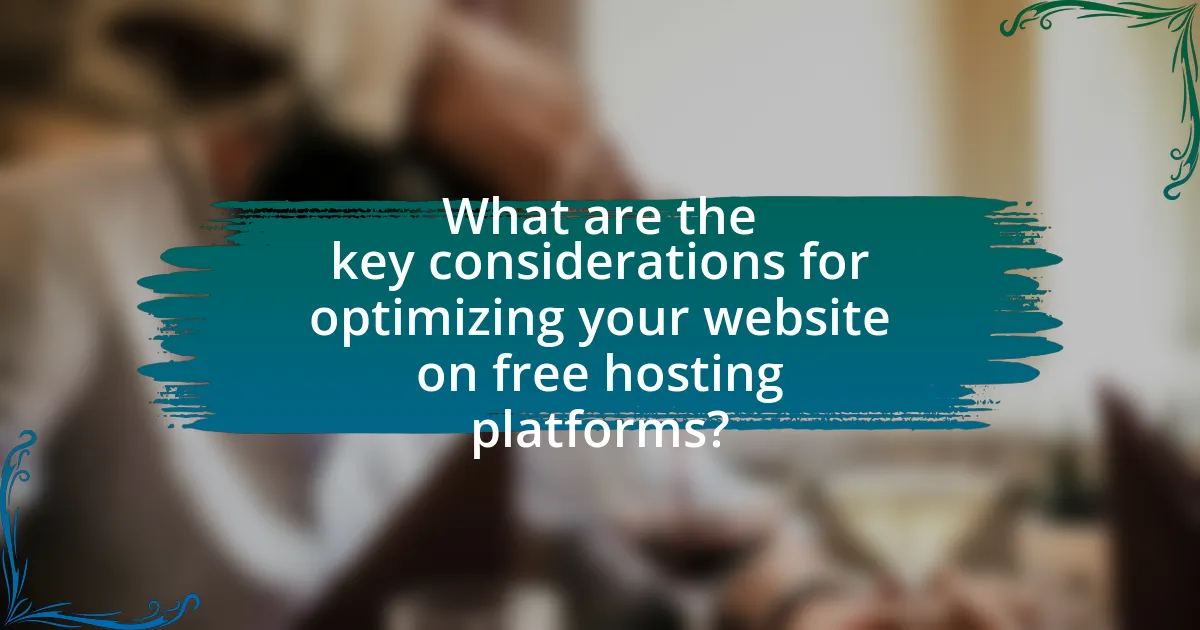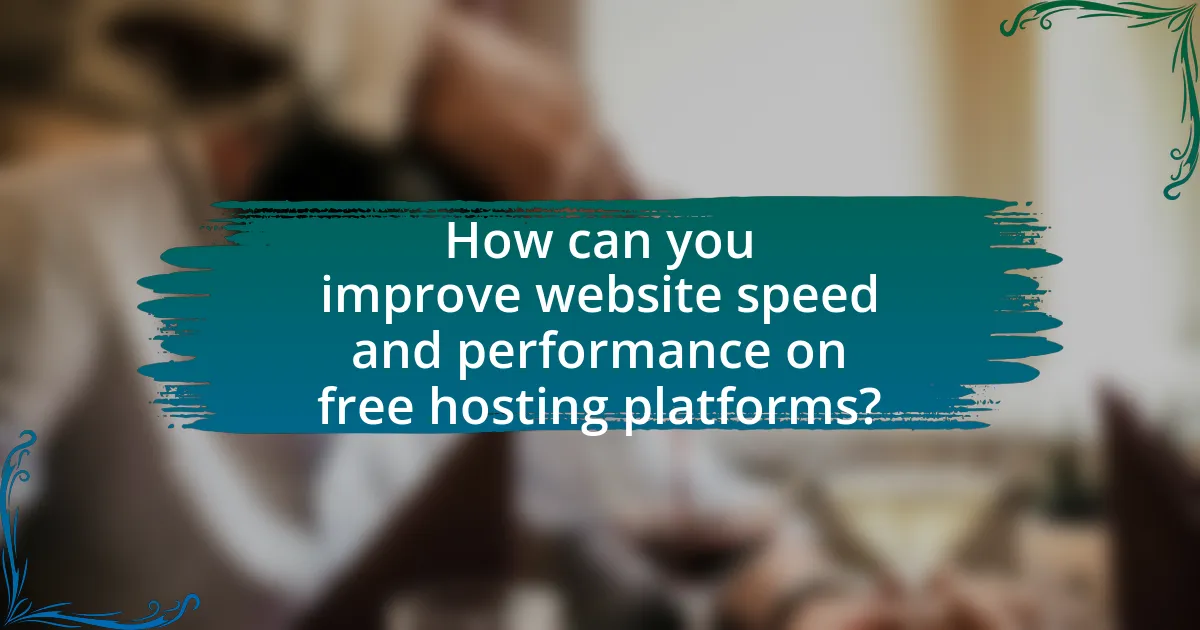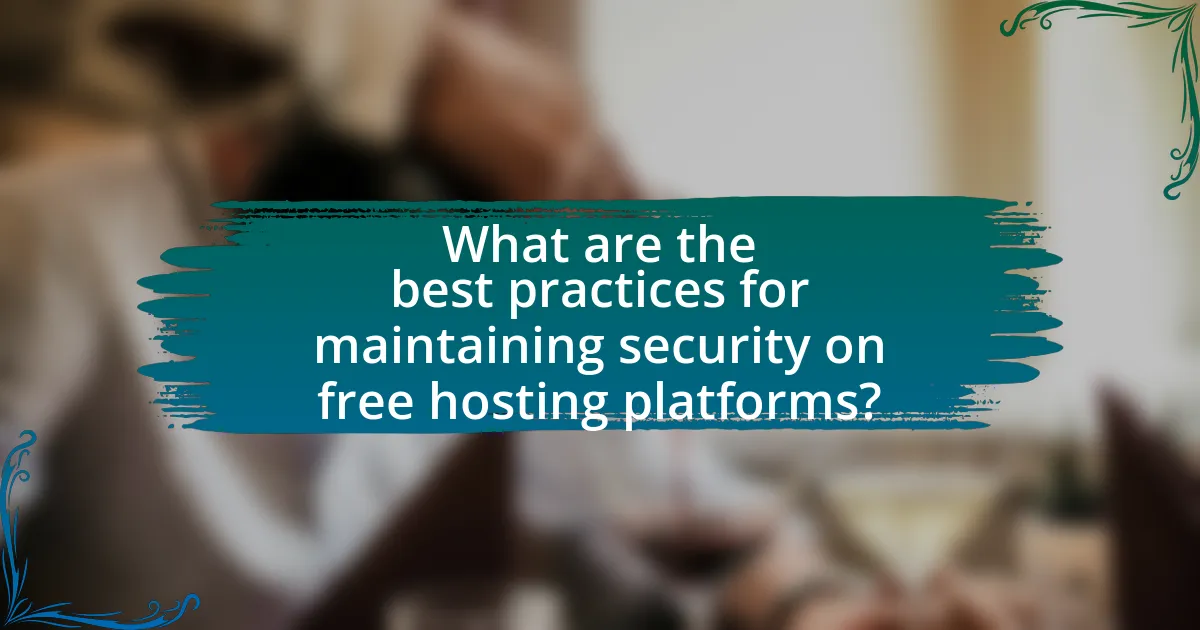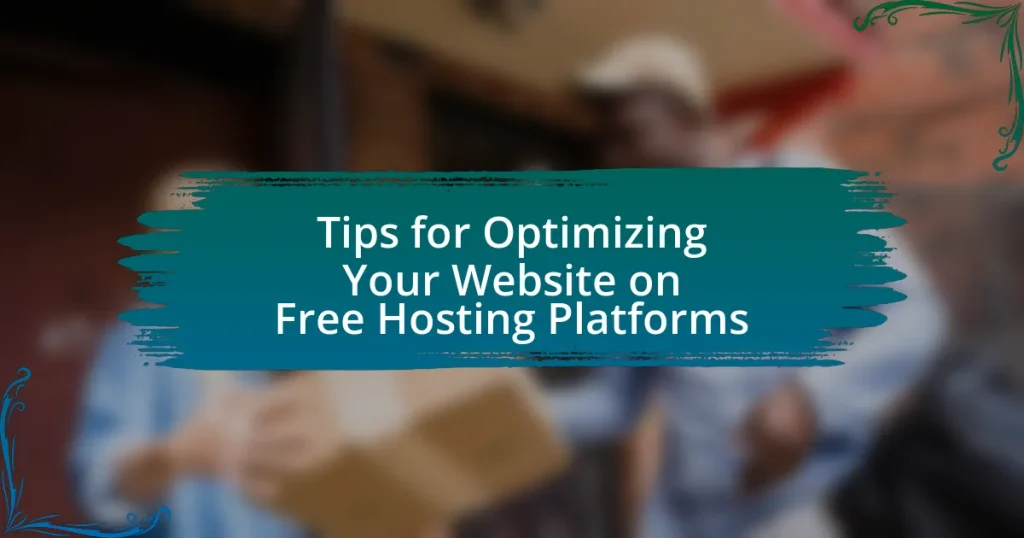The article focuses on optimizing websites hosted on free hosting platforms, emphasizing key considerations such as performance, user experience, and SEO. It outlines the impact of free hosting choices on website performance, detailing factors to evaluate when selecting a provider, including bandwidth, storage, and uptime reliability. The article also discusses common limitations of free hosting, strategies for enhancing visibility, and best practices for maintaining security. Techniques for improving website speed, optimizing images, and utilizing tools for performance tracking are highlighted, providing a comprehensive guide for maximizing the potential of websites on free hosting services.

What are the key considerations for optimizing your website on free hosting platforms?
To optimize your website on free hosting platforms, focus on performance, user experience, and SEO. Performance can be enhanced by minimizing image sizes and using efficient coding practices, as free hosting often has limited resources. User experience should be prioritized by ensuring fast loading times and mobile responsiveness, which are critical for retaining visitors. SEO optimization involves using relevant keywords, optimizing meta tags, and creating quality content to improve search engine rankings. These considerations are essential because studies show that websites with optimized performance and user experience can see up to a 70% increase in user engagement and a significant boost in search visibility.
How does the choice of a free hosting platform impact website performance?
The choice of a free hosting platform significantly impacts website performance by limiting resources such as bandwidth, storage, and server speed. Free hosting services often impose restrictions that can lead to slower loading times, increased downtime, and reduced reliability compared to paid options. For instance, a study by HostingAdvice found that free hosting platforms typically have slower server response times, averaging around 1.5 seconds, while paid services can achieve response times under 0.5 seconds. Additionally, free hosting may include advertisements and lack customer support, further detracting from user experience and site functionality.
What factors should you evaluate when selecting a free hosting provider?
When selecting a free hosting provider, you should evaluate factors such as storage capacity, bandwidth limits, uptime reliability, customer support, and the presence of ads. Storage capacity determines how much data you can host, while bandwidth limits affect the amount of traffic your site can handle. Uptime reliability is crucial for ensuring your website is accessible, with a standard uptime of 99.9% being ideal. Customer support availability can significantly impact your ability to resolve issues quickly. Lastly, the presence of ads can affect user experience and site aesthetics, as many free hosting providers display advertisements on hosted sites.
How do server speed and uptime affect user experience?
Server speed and uptime significantly impact user experience by determining how quickly and reliably users can access a website. Faster server speeds lead to reduced loading times, which studies show can decrease bounce rates; for instance, a one-second delay in page load time can lead to a 7% reduction in conversions. High uptime ensures that a website is consistently available, with a target of 99.9% uptime being standard for optimal user satisfaction. When servers experience downtime, users may encounter error messages, leading to frustration and potential loss of trust in the website. Therefore, both server speed and uptime are critical for maintaining a positive user experience and encouraging user engagement.
What are the common limitations of free hosting platforms?
Free hosting platforms commonly have limitations such as restricted bandwidth, limited storage space, lack of customer support, and the presence of advertisements. These constraints can hinder website performance and user experience. For instance, restricted bandwidth can lead to slow loading times, while limited storage may prevent users from uploading necessary content. Additionally, the absence of customer support can leave users without assistance during technical issues, and advertisements can detract from the site’s professionalism. These factors collectively impact the overall effectiveness of a website hosted on a free platform.
How do bandwidth and storage limits influence website functionality?
Bandwidth and storage limits significantly influence website functionality by restricting the amount of data that can be transferred and stored. When bandwidth is limited, a website may experience slow loading times or become inaccessible during high traffic periods, as it cannot handle multiple requests efficiently. For instance, a website with a bandwidth limit of 1 GB per month may struggle to serve content to users if it receives a surge in visitors, leading to potential downtime or degraded user experience. Similarly, storage limits affect the amount of content, such as images, videos, and databases, that can be hosted. A website with a storage cap of 500 MB may need to delete or compress files to stay within limits, which can hinder the richness of the content offered. Therefore, both bandwidth and storage constraints directly impact a website’s performance, user engagement, and overall functionality.
What restrictions on customization should you be aware of?
Free hosting platforms typically impose restrictions on customization, including limited access to code, predefined templates, and restrictions on third-party integrations. These limitations can hinder the ability to fully tailor the website’s design and functionality to specific needs. For instance, many free hosting services do not allow users to modify HTML or CSS, which restricts the ability to implement unique design elements. Additionally, the use of third-party plugins or custom scripts may be prohibited, further limiting functionality. These constraints are often outlined in the terms of service of the hosting provider, emphasizing the trade-off between cost and flexibility in website customization.
What strategies can enhance your website’s visibility on free hosting platforms?
To enhance your website’s visibility on free hosting platforms, focus on optimizing your content for search engines, utilizing social media for promotion, and engaging with online communities. Optimizing content involves using relevant keywords, creating high-quality articles, and ensuring proper meta tags are in place, which can improve search engine rankings. Social media promotion can drive traffic; sharing links on platforms like Facebook and Twitter can increase exposure. Engaging with online communities, such as forums or niche groups, allows for networking and can lead to backlinks, further boosting visibility. These strategies are supported by data indicating that websites with strong SEO practices and active social media presence see significantly higher traffic levels.
How can SEO practices be effectively implemented on free hosting sites?
SEO practices can be effectively implemented on free hosting sites by optimizing on-page elements, utilizing relevant keywords, and ensuring mobile responsiveness. On-page optimization includes crafting unique title tags and meta descriptions for each page, which helps search engines understand the content. Incorporating relevant keywords naturally within the content enhances visibility in search results. Additionally, ensuring that the website is mobile-friendly is crucial, as Google prioritizes mobile-first indexing, meaning that sites optimized for mobile devices rank higher. According to Google, over 50% of global web traffic comes from mobile devices, emphasizing the importance of this aspect in SEO strategy.
What role does content quality play in attracting visitors?
Content quality is crucial in attracting visitors as it directly influences user engagement and search engine rankings. High-quality content provides valuable information, enhances user experience, and encourages visitors to spend more time on the site. According to a study by HubSpot, companies that prioritize content quality see a 13 times higher return on investment in terms of traffic and leads. Additionally, search engines like Google reward high-quality content with better visibility in search results, leading to increased organic traffic. Therefore, investing in content quality is essential for driving visitor attraction and retention.

How can you improve website speed and performance on free hosting platforms?
To improve website speed and performance on free hosting platforms, optimize images and minimize file sizes. Large images can significantly slow down loading times; using tools like TinyPNG or ImageOptim can reduce file sizes without sacrificing quality. Additionally, leveraging browser caching allows frequently accessed resources to be stored locally on users’ devices, reducing load times on subsequent visits. Implementing a Content Delivery Network (CDN) can also enhance performance by distributing content across multiple servers, thus decreasing latency. According to Google, optimizing images can lead to a 30% improvement in loading speed, demonstrating the effectiveness of these strategies.
What techniques can be used to optimize images and media files?
Techniques to optimize images and media files include compression, resizing, and format selection. Compression reduces file size without significantly affecting quality; tools like JPEGmini and TinyPNG can achieve this effectively. Resizing involves adjusting dimensions to fit display requirements, which minimizes unnecessary data. Format selection is crucial; using formats like WebP for images can provide better compression rates compared to traditional formats like JPEG or PNG. According to Google, using WebP can reduce image file sizes by up to 30% without losing quality, enhancing website loading speed and performance.
How does image compression affect loading times?
Image compression significantly reduces loading times by decreasing the file size of images, which allows for faster data transfer over the internet. When images are compressed, they take up less bandwidth, enabling quicker downloads and rendering on web pages. For instance, studies have shown that optimizing images can lead to a reduction in loading times by up to 70%, which directly enhances user experience and can improve search engine rankings. This efficiency is crucial for websites on free hosting platforms, where resources may be limited.
What formats are best for web images to ensure quality and speed?
The best formats for web images to ensure quality and speed are JPEG, PNG, and WebP. JPEG is ideal for photographs due to its efficient compression, maintaining quality while reducing file size. PNG is suitable for images requiring transparency and sharp edges, though it typically results in larger file sizes. WebP offers superior compression and quality, supporting both lossy and lossless formats, making it a versatile choice for modern web applications. According to Google, WebP images can be 25-34% smaller than comparable JPEG images, enhancing loading speed without sacrificing visual fidelity.
How can caching and content delivery networks (CDNs) enhance performance?
Caching and content delivery networks (CDNs) enhance performance by reducing latency and improving load times for users. Caching stores frequently accessed data closer to the user, minimizing the time it takes to retrieve information. CDNs distribute content across multiple geographically dispersed servers, allowing users to access data from the nearest location, which significantly decreases the distance data must travel. For instance, a study by Akamai found that a 100-millisecond delay in load time can decrease conversion rates by 7%. This demonstrates that both caching and CDNs are critical for optimizing website performance, especially on free hosting platforms where resources may be limited.
What is the role of caching in website speed optimization?
Caching plays a crucial role in website speed optimization by storing frequently accessed data temporarily, which reduces the time needed to retrieve that data on subsequent requests. When a user visits a website, caching allows the server to deliver content quickly by serving it from the cache rather than generating it anew each time. This process significantly decreases load times, enhances user experience, and can lead to improved search engine rankings. Studies show that websites utilizing caching can achieve load time reductions of up to 70%, demonstrating its effectiveness in optimizing performance.
How can CDNs help in distributing content efficiently?
Content Delivery Networks (CDNs) enhance content distribution efficiency by caching content across multiple geographically dispersed servers. This architecture reduces latency, as users access data from the nearest server, resulting in faster load times. For instance, a study by Akamai found that a 100-millisecond delay in load time can decrease conversion rates by 7%. Additionally, CDNs optimize bandwidth usage and mitigate server overload during traffic spikes, ensuring consistent performance. By distributing content closer to users, CDNs significantly improve the overall user experience and site reliability.

What are the best practices for maintaining security on free hosting platforms?
To maintain security on free hosting platforms, users should implement strong passwords and enable two-factor authentication. Strong passwords reduce the risk of unauthorized access, while two-factor authentication adds an additional layer of security, making it significantly harder for attackers to gain entry. According to a study by Verizon, 81% of data breaches are linked to weak or stolen passwords, highlighting the importance of robust password practices. Additionally, users should regularly update their software and plugins to patch vulnerabilities, as outdated systems are prime targets for cyberattacks. Regular backups of website data are also crucial, ensuring that users can restore their sites in case of a security breach.
How can you protect your website from common security threats?
To protect your website from common security threats, implement strong password policies, utilize HTTPS, and regularly update software. Strong passwords reduce the risk of unauthorized access, while HTTPS encrypts data transmitted between users and the server, preventing interception. Regular software updates patch vulnerabilities, as evidenced by a report from the Cybersecurity & Infrastructure Security Agency, which states that 85% of successful cyberattacks exploit known vulnerabilities in outdated software. Additionally, employing firewalls and security plugins can further enhance protection against threats such as SQL injection and cross-site scripting.
What measures should be taken to secure user data?
To secure user data, implement strong encryption protocols for data transmission and storage. Utilizing HTTPS ensures that data exchanged between users and the website is encrypted, protecting it from interception. Additionally, regular software updates and security patches are essential to mitigate vulnerabilities that could be exploited by attackers. According to a report by the Ponemon Institute, 60% of small businesses that experience a data breach go out of business within six months, highlighting the critical importance of robust security measures. Employing multi-factor authentication adds an extra layer of security, making unauthorized access significantly more difficult. Regular security audits and user education on safe practices further enhance data protection efforts.
How can regular updates and backups safeguard your site?
Regular updates and backups safeguard your site by ensuring that software vulnerabilities are patched and that data is recoverable in case of loss. Updates to your website’s platform, plugins, and themes close security gaps that could be exploited by hackers; for instance, a study by the Cybersecurity & Infrastructure Security Agency found that 60% of breaches are due to unpatched vulnerabilities. Backups provide a safety net, allowing you to restore your site to a previous state if data is lost due to cyberattacks, server failures, or human error. Regularly scheduled backups, ideally automated, ensure that you have the most recent version of your site available for recovery, minimizing downtime and data loss.
What tools and resources can assist in optimizing your website?
Tools and resources that can assist in optimizing your website include Google Analytics, which provides insights into user behavior and traffic sources, and Google Search Console, which helps monitor site performance in search results. Additionally, tools like GTmetrix and PageSpeed Insights analyze page load speed and offer suggestions for improvement. For SEO optimization, resources such as Moz and SEMrush provide keyword research and competitive analysis. These tools are widely recognized in the industry for their effectiveness in enhancing website performance and visibility.
Which analytics tools are most effective for tracking performance?
Google Analytics is one of the most effective analytics tools for tracking performance. It provides comprehensive insights into website traffic, user behavior, and conversion rates, allowing users to analyze data in real-time. According to a report by Statista, Google Analytics holds a market share of over 80% among web analytics tools, demonstrating its widespread adoption and reliability. Other effective tools include Adobe Analytics, which offers advanced segmentation and predictive analytics, and Matomo, known for its privacy-focused features. These tools collectively enable website owners to optimize their performance effectively.
How can website builders simplify the optimization process?
Website builders simplify the optimization process by providing built-in tools and features that enhance website performance without requiring technical expertise. These platforms often include automated SEO settings, responsive design templates, and integrated analytics, which streamline the optimization tasks that would otherwise require manual coding or extensive knowledge of web development. For instance, many website builders automatically generate meta tags and sitemaps, which are crucial for search engine indexing, thereby reducing the complexity of SEO for users. Additionally, the use of pre-designed templates ensures that websites are mobile-friendly, which is essential for user experience and search rankings, as Google prioritizes mobile-optimized sites in its search results.
What are the top tips for maximizing your website’s potential on free hosting platforms?
To maximize your website’s potential on free hosting platforms, focus on optimizing site speed and user experience. Fast-loading websites retain visitors, as studies show that a one-second delay can reduce conversions by 7%. Utilize lightweight themes and optimize images to enhance loading times. Additionally, ensure your website is mobile-friendly, as over 50% of global web traffic comes from mobile devices. Implementing responsive design can significantly improve user engagement. Lastly, leverage SEO best practices, such as keyword optimization and quality content, to increase visibility; websites that rank higher in search results receive 33% more traffic.


